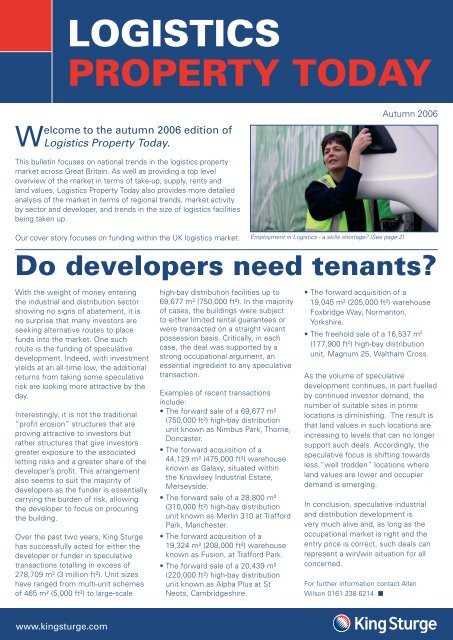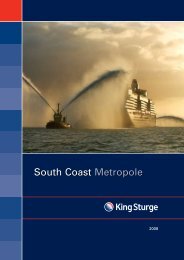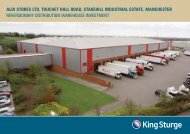LOGISTICS PROPERTY TODAY - King Sturge
LOGISTICS PROPERTY TODAY - King Sturge
LOGISTICS PROPERTY TODAY - King Sturge
Create successful ePaper yourself
Turn your PDF publications into a flip-book with our unique Google optimized e-Paper software.
www.kingsturge.com<br />
<strong>LOGISTICS</strong><br />
<strong>PROPERTY</strong> <strong>TODAY</strong><br />
Welcome to the autumn 2006 edition of<br />
Logistics Property Today.<br />
This bulletin focuses on national trends in the logistics property<br />
market across Great Britain. As well as providing a top level<br />
overview of the market in terms of take-up, supply, rents and<br />
land values, Logistics Property Today also provides more detailed<br />
analysis of the market in terms of regional trends, market activity<br />
by sector and developer, and trends in the size of logistics facilities<br />
being taken up.<br />
Our cover story focuses on funding within the UK logistics market.<br />
With the weight of money entering<br />
the industrial and distribution sector<br />
showing no signs of abatement, it is<br />
no surprise that many investors are<br />
seeking alternative routes to place<br />
funds into the market. One such<br />
route is the funding of speculative<br />
development. Indeed, with investment<br />
yields at an all-time low, the additional<br />
returns from taking some speculative<br />
risk are looking more attractive by the<br />
day.<br />
Interestingly, it is not the traditional<br />
“profit erosion” structures that are<br />
proving attractive to investors but<br />
rather structures that give investors<br />
greater exposure to the associated<br />
letting risks and a greater share of the<br />
developer’s profit. This arrangement<br />
also seems to suit the majority of<br />
developers as the funder is essentially<br />
carrying the burden of risk, allowing<br />
the developer to focus on procuring<br />
the building.<br />
Over the past two years, <strong>King</strong> <strong>Sturge</strong><br />
has successfully acted for either the<br />
developer or funder in speculative<br />
transactions totalling in excess of<br />
278,709 m² (3 million ft²). Unit sizes<br />
have ranged from multi-unit schemes<br />
of 465 m² (5,000 ft²) to large-scale<br />
high-bay distribution facilities up to<br />
69,677 m² (750,000 ft²). In the majority<br />
of cases, the buildings were subject<br />
to either limited rental guarantees or<br />
were transacted on a straight vacant<br />
possession basis. Critically, in each<br />
case, the deal was supported by a<br />
strong occupational argument, an<br />
essential ingredient to any speculative<br />
transaction.<br />
Examples of recent transactions<br />
include:<br />
• The forward sale of a 69,677 m²<br />
(750,000 ft²) high-bay distribution<br />
unit known as Nimbus Park, Thorne,<br />
Doncaster.<br />
• The forward acquisition of a<br />
44,129 m² (475,000 ft²) warehouse<br />
known as Galaxy, situated within<br />
the Knowlsey Industrial Estate,<br />
Merseyside.<br />
• The forward sale of a 28,800 m²<br />
(310,000 ft²) high-bay distribution<br />
unit known as Merlin 310 at Trafford<br />
Park, Manchester.<br />
• The forward acquisition of a<br />
19,324 m² (208,000 ft²) warehouse<br />
known as Fusion, at Trafford Park.<br />
• The forward sale of a 20,439 m²<br />
(220,000 ft²) high-bay distribution<br />
unit known as Alpha Plus at St<br />
Neots, Cambridgeshire.<br />
Employment in Logistics - a skills shortage? (See page 2)<br />
Autumn 2006<br />
Do developers need tenants?<br />
• The forward acquisition of a<br />
19,045 m² (205,000 ft²) warehouse<br />
Foxbridge Way, Normanton,<br />
Yorkshire.<br />
• The freehold sale of a 16,537 m 2<br />
(177,900 ft 2 ) high-bay distribution<br />
unit, Magnum 25, Waltham Cross.<br />
As the volume of speculative<br />
development continues, in part fuelled<br />
by continued investor demand, the<br />
number of suitable sites in prime<br />
locations is diminishing. The result is<br />
that land values in such locations are<br />
increasing to levels that can no longer<br />
support such deals. Accordingly, the<br />
speculative focus is shifting towards<br />
less “well trodden” locations where<br />
land values are lower and occupier<br />
demand is emerging.<br />
In conclusion, speculative industrial<br />
and distribution development is<br />
very much alive and, as long as the<br />
occupational market is right and the<br />
entry price is correct, such deals can<br />
represent a win/win situation for all<br />
concerned.<br />
For further information contact Allan<br />
Wilson 0161 238 6214. n
Employment in Logistics Industry – a skills shortage?<br />
Table 1 Employees of working age in UK logistics<br />
Logistics – a major source of<br />
employment<br />
Logistics activities support around 1.73<br />
million employee jobs in the UK, according<br />
to Skills for Logistics, the Sector Skills<br />
Council for freight logistics. This estimate<br />
is based on official data derived from the<br />
Annual Population Survey (APS) using<br />
selective Standard Industrial Classifications<br />
to capture relevant logistics industries and<br />
Standard Occupational Classifications to<br />
capture appropriate logistics occupations.<br />
This means that logistics accounts for<br />
some 7% of all employees of working age<br />
in the UK. Table 1 provide a breakdown of<br />
employees of working age in logistics in the<br />
UK.<br />
Large warehouses can generate a<br />
significant numbers of jobs and a variety<br />
of employment opportunities, so the<br />
availability of labour and its quality have<br />
become increasingly important location<br />
factors for occupiers, in addition to<br />
traditional location criteria such as proximity<br />
to motorways<br />
Driver shortages continue<br />
Skills for Logistics estimates that there<br />
is currently a significant shortage of LGV<br />
drivers in the UK, although this shortage<br />
is not as great as had previously been<br />
anticipated. It conducted a Survey of<br />
employers of LGV drivers last year which<br />
questioned some 1,200 companies in the<br />
UK. Companies indicated an 8% shortfall<br />
of drivers, which approximates to 25,000<br />
drivers if applied to the whole UK. After<br />
factoring in various assumptions, such as<br />
new recruits, military and foreign sources<br />
of labour, SfL predicts that there could be<br />
a shortage of approximately 15,000 LGV<br />
drivers in the UK Logistics industry by the<br />
middle of the 2006/07 financial year. It also<br />
found that the recruitment of new drivers<br />
Employment on<br />
logistics role<br />
SOC Definition Logistics<br />
‘sector’*<br />
9149 Other goods handling & storage<br />
occupations<br />
Other<br />
sectors<br />
Total in Logistics<br />
sector and related<br />
roles<br />
Number %<br />
110,800 267,300 378,100 22%<br />
8211 Heavy good vehicle drivers 169,200 135,100 304,300 18%<br />
9211 Post worker, mail sorter, messenger or<br />
courier<br />
174,200 41,400 215,600 12%<br />
8212 Van drivers 59,800 144,800 204,600 12%<br />
1161 Transport and distribution managers 36,600 46,700 83,300 5%<br />
1162 Storage and warehouse managers 13,400 60,000 73,400 4%<br />
4134 Transport and distribution clerks 21,000 38,900 59,900 3%<br />
Other occupations 411,800 411,800 24%<br />
Total 996,800 1,731,000<br />
Source: Skills for Logistics, based on APS 2005<br />
*Logistics sector defined in terms of selective Standard Industrial Classifications<br />
was perceived as either ‘very difficult’ or<br />
‘difficult’ by nearly half of al employers.<br />
The shortage of drivers reflects a number<br />
of key factors. First, there is evidence<br />
that the ageing workforce is a problem<br />
contributing to labour shortage amongst<br />
LGV drivers but this is not conclusive.<br />
Official statistics (APS 2005) indicate that<br />
nearly a quarter of drivers were aged 55 or<br />
over. However the Survey of employers of<br />
LGV drivers (2005) by SfL estimate this to<br />
be around 16%.<br />
Second, it is clear that the industry is not<br />
attracting enough young people. Official<br />
statistics (Labour Market Intelligence)<br />
indicate that only 3.1% of the industry<br />
is under the age of 25. School leavers<br />
cannot join the industry without significant<br />
delay, due to the minimum age for gaining<br />
a category C+E licence being 21. Many<br />
firms will only accept employees aged 25<br />
or over, for insurance reasons. An additional<br />
problem seems to be that companies prefer<br />
to recruit drivers from other companies<br />
rather than investing in training. According<br />
to the SfL Survey, employers recruit 64%<br />
of their drivers from other companies.<br />
Trainees represented only 16% of the<br />
workforce.<br />
Third, the industry still has a poor image<br />
which is problematic for attracting new<br />
recruits. There is a general perception of<br />
low pay, long hours, stressful conditions,<br />
poor working environment, heavy<br />
supervision and poor career prospects.<br />
Traditionally, lorry drivers tend to be white,<br />
middle aged men. Official statistics indicate<br />
that only 0.4% of LGV drivers are female.<br />
This is something that SfL is beginning to<br />
address. SfL, together with the FTA have<br />
just hosted the second Women in Transport<br />
event aimed at highlighting gender issues<br />
in the industry. Higher numbers of female<br />
recruits in the future could be a means to<br />
avert a future skills shortage.<br />
Is foreign labour filling the gap?<br />
The prediction by SfL of 15,000 LGV drivers<br />
by the middle of 2006/07 financial year is<br />
much lower than anticipated two years<br />
ago when it was forecast at 46,000. This<br />
is partly due to the effects of the Road<br />
Transport Directive not being as severe as<br />
predicted, but can also be explained by an<br />
influx of foreign drivers following the EU<br />
expansion in 2004.<br />
Some firms believe that the shortage of<br />
LGV drivers will be remedied by utilising<br />
foreign labour, particularly from eastern<br />
Europe. In May 2004 Poland and seven<br />
other mainly former communist states<br />
joined the European Union. By June this<br />
year a total of 447,000 eastern Europeans<br />
had registered to work in Britain. Most<br />
(an estimated 264,000) have come from<br />
Poland.<br />
This may not prove a long term solution as<br />
there is already evidence of a downward<br />
trend in the numbers, 57,000 who<br />
registered between April and June last year<br />
down to 52,195 this year. The Workers’<br />
Registration Scheme figures published<br />
in August 2006 show that 49% were in<br />
temporary jobs, suggesting that they were<br />
likely to go back within two or three years.<br />
Recruitment of eastern European<br />
drivers could in the future create a skills<br />
shortage in central and eastern Europe,<br />
which are seeing considerable growth in<br />
warehousing.<br />
The government has announced that when<br />
Bulgaria and Romania join the EU next<br />
year there will be strict limitations to work<br />
permits imposed, with low-skilled workers<br />
only allowed to work in the food processing<br />
and agricultural sectors, so the positive<br />
effects of foreign labour migration may<br />
prove short lived.<br />
The shortage of LGV drivers in the UK<br />
logistics industry, although less than half of<br />
what was estimated two years ago should<br />
nevertheless not be underestimated.<br />
The impact of a foreign labour influx from<br />
expansion of the EU has helped mitigate<br />
the shortage, but may prove short lived as<br />
large numbers of people begin to return to<br />
their country of origin over the next two to<br />
four years. The industry needs to find ways<br />
to address certain problems such as the<br />
image of the industry, recruitment of young<br />
drivers and retaining current drivers.
NEWS & STORIES<br />
DC2, South Marston Park, Swindon<br />
DC2 is the largest existing speculative distribution<br />
development in the South West. <strong>King</strong> <strong>Sturge</strong> is acting<br />
as joint agent. Developed by ProLogis, it provides<br />
approximately 28,056 m² (302,000 ft²).<br />
South Marston Park is situated just 5 miles north<br />
of junction 15 of the M4 and accessed off the dual<br />
carriageway A419. It is ideally situated for access to<br />
London, the Midlands and the South West.<br />
For further information contact Tim Johnson on 020<br />
7087 5300 or Giles Weir 01793 553 976. n<br />
Galaxy, Knowsley<br />
<strong>King</strong> <strong>Sturge</strong> is joint letting agent for Galaxy, a recently<br />
completed 44,129 m² (475,000 ft²) speculative<br />
distribution facility on Knowsley Industrial Park, located<br />
close to junctions 4 and 5 of the M57.<br />
Developed by Patrick Properties in partnership with<br />
LNC, the development comprises a new manufacturing/<br />
warehouse facility of 43,264 m² (465,692 ft²) plus twostorey<br />
offices of 971 m² (10,452 ft²).<br />
For further information contact David Brooks 0161 238<br />
6239 or Alastair Newman 0151 242 6601. n<br />
Merlin 310, Trafford Park, Manchester<br />
This is a 28,800 m² (310,000 ft²) warehouse currently<br />
under construction with completion due in February<br />
2007. The scheme is stategically located close to<br />
Junction 9 of the M60. It is being developed by<br />
Quorum Developments and funded by Morley Fund<br />
Management. <strong>King</strong> <strong>Sturge</strong> is joint agent.<br />
For further information contact Steve Johnson 0161 238<br />
6238. n<br />
Lymedale 414 at Lymedale Cross,<br />
Newcastle-under-Lyme<br />
Being developed by HelioSlough, this is a new<br />
speculative high-bay distribution unit of 38,461 m 2<br />
(414,000 ft 2 ) currently under construction. <strong>King</strong> <strong>Sturge</strong><br />
is acting as joint letting agent. The property is situated<br />
in a strategic location with direct access off the A34<br />
providing swift access to junctions 15 and 16 of the M6.<br />
For further information contact Steve Johnson on 0161<br />
238 6238. n<br />
OCCUPIER DEMAND<br />
The national picture<br />
In the first nine months of 2006 some 1,066,809 m² (11,483,036 ft²) was taken up in 37<br />
new distribution units across Britain (of 10,000 m² and over). This has already overtaken the<br />
10-year annual average of 1.0 million m² (10,763,910 ft²). We expect the level of take-up in<br />
2006 to exceed the total for last year, which reached 1.1 million m².<br />
Take-up of new logistics facilities of 10,000 m 2 and over in GB<br />
m 2<br />
1800000<br />
1600000<br />
1400000<br />
1200000<br />
1000000<br />
800000<br />
600000<br />
400000<br />
200000<br />
0<br />
1996<br />
Source: <strong>King</strong> <strong>Sturge</strong><br />
1997<br />
1998<br />
1999<br />
2000<br />
2001<br />
2002<br />
2003<br />
2004 2005 2006<br />
end Q3<br />
0<br />
Floorspace No. of occupier transactions<br />
The amount of speculative development has continued to rise to unprecedented levels in<br />
2006. This increase in speculative stock has correspondingly led to a rise in the amount<br />
of speculatively developed space taken up, which, at end Q3 2006, stood at 43.5% of all<br />
floorspace. This is a record figure and has almost doubled from September 2005 when it stood<br />
at 21.8%. This compares with an annual average trend of 11.6% over the past 10 years.<br />
Regions<br />
In the first three quarters of 2006, the largest percentage of take-up of units over 10,000 m²<br />
took place in the East and West Midlands, together representing 36.4% of the total floorspace<br />
transacted, which was lower than the 1996 level of 43.8%. The West Midlands take-up was<br />
18.5% and the East Midlands was 17.9%. Following the Midlands, the next largest region<br />
was the South East/East (including London), which took a share of 29.4%, up from 14.2% in<br />
1996. However, 10.8% of this increase can be accounted for by the IKEA transaction at Bury<br />
St Edmunds, where IKEA has secured planning consent for 114,896 m² (1,236,730 ft²). At Q3<br />
2006 the share of take-up in Yorkshire and Humberside was 11.9%, compared to zero in 1996.<br />
Scotland had also shown a marked increase, with 1.8% of recorded transactions there in 1996,<br />
but by end Q3 2006 it stood at 8.3% of the market. There has been a notable decrease in the<br />
share of transactions of logistics facilities over 10,000 m² in the North West, which has declined<br />
from the 1996 level of 23.5% to 10.5% at September 2006.<br />
Regional take-up of new logistics facilities of 10,000 m 2 and over in GB<br />
0.0%<br />
23.5%<br />
28.3%<br />
0.0%<br />
1.8%<br />
Source: <strong>King</strong> <strong>Sturge</strong><br />
1996 2006 end Q3<br />
14.2%<br />
15.5%<br />
16.7%<br />
11.9%<br />
10.5%<br />
3.5%<br />
17.9%<br />
8.3%<br />
29.4%<br />
18.5%<br />
0.0%<br />
80<br />
70<br />
60<br />
50<br />
40<br />
30<br />
20<br />
10<br />
Transactions<br />
South East/East (incl. London)<br />
South West & Wales<br />
West Midlands<br />
East Midlands<br />
Yorkshire & Humber<br />
North East<br />
North West<br />
Scotland
NEWS & STORIES<br />
Fusion at Trafford Park, Manchester<br />
Fusion at Trafford Park, Manchester, is a new high-bay<br />
warehouse facility developed by CDP and funded by<br />
Legal & General, available to let through <strong>King</strong> <strong>Sturge</strong>.<br />
Fusion is located in the heart of Trafford Park at the<br />
Europa Gate roundabout, which links Westinghouse<br />
Road with Europa Way and John Gilbert Way. Electric<br />
Park has already attracted the national distribution<br />
centres for Kellogg’s, L’Oreal and Associated British<br />
Foods, highlighting the strength of this location. The<br />
accommodation comprises a warehouse of 18,580 m²<br />
(200,000 ft²) and a two-storey office of743 m² (8,000 ft²).<br />
The warehouse consists of a 15m eaves height and has<br />
16 dock and three level access loading doors.<br />
For further information contact David Brooks 0161 238<br />
6239. n<br />
ProLogis Park, Stafford<br />
Two new distribution warehouses remain available to let<br />
through <strong>King</strong> <strong>Sturge</strong>. The available units are:<br />
DC1 (Crossflow 540): 50,675 m 2 (545,470 ft 2 ) (has<br />
recently been let to Screwfix Direct);<br />
DC2: 11,877 m 2 (127,845 ft 2 ) ;<br />
DC3: 6,528 m 2 (70,270 ft 2 ).<br />
These three buildings represent Phase 1 of the<br />
development. Phase 2 (likely to complete in summer<br />
2007) will comprise 21,368 m 2 (230,000 ft 2 ). Positioned<br />
at junction 14 of the M6, ProLogis Park, Stafford<br />
is strategically located in the central M6 corridor.<br />
Birmingham is 28 miles to the south and Manchester is<br />
58 miles to the north.<br />
For further information contact Carl Durant or Steve<br />
Johnson: 0121 200 7147 or 0161 238 6238 respectively.<br />
n<br />
M400 Heywood Distribution Park,<br />
Manchester<br />
Planning consent has been obtained by Slough Estates<br />
for up to 37,161 m 2 (400,000 ft 2 ) in a single building as<br />
a design and build opportunity. <strong>King</strong> <strong>Sturge</strong> is jointly<br />
marketing the opportunity.<br />
For further information contact David Brooks 0161 238<br />
6239. n<br />
Sectors<br />
The non-food retail sector has been the dominant sector in the take-up of new units over<br />
10,000 m², accounting for 39.2% to Q3 2006. This compares with a share of 23.4% from<br />
the amount taken up in 2005.<br />
The rest of the floorspace was distributed relatively evenly among logistics companies,<br />
manufacturers, and food retailers, which took up 19.1%, 17.5% and 16.7% respectively,<br />
with “others” accounting for 7.4%.<br />
Take-up of new logistics facilities of 10,000 m 2 and over by sector<br />
%<br />
100<br />
90<br />
80<br />
70<br />
60<br />
50<br />
40<br />
30<br />
20<br />
10<br />
0<br />
2001<br />
Source: <strong>King</strong> <strong>Sturge</strong><br />
2002<br />
Non-food retailers<br />
2003<br />
2004<br />
Food Retailer<br />
2005<br />
2006<br />
end Q3<br />
Other Manufacturer Logistics company<br />
Size analysis<br />
The average size of units over 10,000 m² taken up in new logistics facilities has picked up<br />
again in 2006 following a dip in 2005. At the end of Q3 2006 it stood at its highest level in<br />
10 years at 28,833 m² (310,355 ft²), compared with 21,203 m² (228,227 ft²) in 1996.<br />
Average size of unit taken-up in new logistics facilities of 10,000 m 2 and over<br />
m 2<br />
35,000<br />
30,000<br />
25,000<br />
20,000<br />
15,000<br />
10,000<br />
5,000<br />
0<br />
1996<br />
Source: <strong>King</strong> <strong>Sturge</strong><br />
1997<br />
1998<br />
1999<br />
2000<br />
Trend line<br />
2001<br />
2002<br />
2003<br />
2004<br />
2005 2006<br />
end Q3
NEWS & STORIES<br />
Big Sam, Wingates Industrial Estate,<br />
Bolton<br />
<strong>King</strong> <strong>Sturge</strong> has acquired Big Sam for Handleman UK<br />
. This is a 25,520 m 2 (274,700 ft 2 ) speculative high-bay<br />
warehouse developed by Barwood and Arlington.<br />
The 25,520 m 2 (274,700 ft 2 ) unit includes cross-docking<br />
facilities with eight dock levellers and four level access<br />
doors on each side with a 14m clear headroom.<br />
For further information contact David Brooks 0161 238<br />
6239. n<br />
Wynard 360, Wynard Park, Tees Valley<br />
<strong>King</strong> <strong>Sturge</strong> is currently marketing this 35,303 m 2<br />
(300,000 ft 2 ) warehouse which has recently completed<br />
and is now available to let. The developer is HelioSlough.<br />
For further information contact Simon Hill 0191 279<br />
0006. n<br />
Nimbus Park, Thorne, Doncaster<br />
<strong>King</strong> <strong>Sturge</strong> is acting as joint agent for developer<br />
HelioSlough to market the UK’s largest speculative<br />
logistics scheme - a 69,677 m 2 (750,000 ft 2 ) warehousing<br />
and distribution complex on a 60 acre site at Thorne,<br />
Doncaster, adjacent to the M18 at junction 6, around 8<br />
miles to the north-east of Doncaster town centre.<br />
Construction work on the development is underway and<br />
on target for completion before the end of the year.<br />
A single user is being sought by <strong>King</strong> <strong>Sturge</strong> at a rent of<br />
£4.75 per ft 2 .<br />
Phase 1 will include 92 dock-level entry doors, 113<br />
dedicated trailer parking spaces, three-storey offices, a<br />
gatehouse-controlled entrance, HGV vehicle wash and<br />
refuelling facilities. A dedicated railway siding could<br />
also be incorporated to the development to facilitate rail<br />
freight transport from the Doncaster-Hull line.<br />
For further information contact Richard Harris 0113 235<br />
5249. n<br />
Units 5010 and 5020 G Park, Western<br />
Approach, Bristol<br />
This is the largest proposed speculative scheme in the<br />
Bristol area, totalling over 29,729 m 2 (320,000 ft 2 ) in<br />
two buildings of 10,916 m 2 (117,500 ft 2 ) and 19,045 m 2<br />
(205,000 ft 2 ). Planning has been secured and a start is<br />
due on site in January. The developer is Gazeley, funded<br />
by Hermes. <strong>King</strong> <strong>Sturge</strong> is joint agent.<br />
For further information contact Paul Baker 0117 930. n<br />
SUPPLY<br />
Speculative development<br />
The level of new speculatively built logistics space available in new units over 10,000 m²<br />
has continued to increase in 2006. There were 67 units either immediately available or<br />
under construction at the end of Q3 2006, accounting for 1.57 million m² (16,899,339 ft²) of<br />
floorspace, compared with 1.25 million m² (13,454,888 ft²) in the same period a year ago,<br />
representing an increase of 26%.<br />
One noticeable change from one year ago was in units in the band 25,000 m² to<br />
49,999 m². The number of units available/under construction doubled from 9 to 18 and in<br />
terms of space represented a 96.2% increase in floorspace.<br />
Available* logistics facilities of 10,000 m² and over, end-September 2006<br />
Size band No. of units Total floorspace (m²)<br />
10,000 to 24,999 m² 44 672,451<br />
25,000 to 49,999 m² 18 602,652<br />
50,000 m² and over 5 296,904<br />
Total 59 1,572,007<br />
* Available schemes comprise newly completed buildings and units under construction<br />
Of available space at end-September 2006 ProLogis held the largest share at 18% of total<br />
available floorspace. Other major developers such as Gladman, Gazeley and Rosemound<br />
accounted for 12%, 11% and 8% respectively.<br />
Land supply and land values<br />
Six of the 10 regions listed in the table below have shown significant uplift in land values<br />
over the last 12 months. This is an indicator of the limited supply of good quality logistics<br />
stock in Britain.<br />
As reported in the spring issue of Logistics Property Today, Scotland has seen the largest<br />
increase in land values over the last year, rising from £200,000 to £300,000 per acre,<br />
representing an increase of 50%.<br />
The East Midlands has seen significant growth in land values over the past year, up from<br />
£350,000 to £450,000 per acre (28.6%). Land values have also notably increased in the<br />
North West, from £300,000 to £350,000 per acre (16.7%) and in the South West, from<br />
£350,000 to £400,000 per acre (14.3%), with the South East (excluding Heathrow) and<br />
Wales showing smaller increases of 13.6% and 12.5% respectively.<br />
The West Midlands, East Anglia, Yorkshire and Humberside and the North East have shown<br />
no change in logistics land values over the past year.<br />
Logistics Land Values, September 2006<br />
Region £ per acre<br />
South East (excl. Heathrow) 850,000-1,100,000<br />
West Midlands 500,000<br />
East Anglia 300,000-400,000<br />
South West 300,000-400,000<br />
East Midlands 250,000-450,000<br />
North West 250,000-350,000<br />
Yorkshire & Humberside 200,000-250,000<br />
Scotland 150,000-300,000<br />
Wales 200,000-225,000<br />
North East 100,000-150,000<br />
Note: Land values are based on prime locations
RENTS<br />
The South East dominates prime rents for large logistics facilities at £6.50-8.50 per<br />
ft², followed by the West Midlands at £5.75-6.50 per ft². Elsewhere in Britain, prime<br />
rents range from £4.00 - £4.50 per ft² in the North East to £4.75 – 5.50 per ft² in the<br />
South West.<br />
Prime logistics rents<br />
Region £ per ft²<br />
South East (excluding Heathrow) 6.50-8.50<br />
West Midlands 5.75-6.50<br />
East Anglia 5.00-5.50<br />
South West 4.75-5.50<br />
East Midlands 4.50-5.25<br />
North West 4.25-4.75<br />
Yorkshire & Humberside 4.25-4.50<br />
Scotland 5.25-5.75<br />
Wales 4.25-4.50<br />
North East 4.00-4.50<br />
Note: Based on a minimum ten-year lease<br />
INVESTMENT COMMENT<br />
There continues to be strong investor demand for large distribution facilities. As a result<br />
the downward pressure on yields has continued. Prime yields are around 5.5% or better,<br />
assuming a 15-year lease, with yields between 6.0% and 6.5% for five-year income.<br />
Evidence of 10-year income includes the sale of TNT at Magna Park, Lutterworth.<br />
Pickering Properties acquired this unit of 229,213 ft² by way of a forward commitment<br />
for £23.1m, equating to 5.3% NIY.<br />
Also at Magna Park, Pickering Properties bought by way of a forward commitment a<br />
unit which will be occupied by Geodis. The lease term agreed is 10 years with a tenant’s<br />
break at year 5. The purchase price equates to 6.12% NIY.<br />
All data contained in this report has been compiled by <strong>King</strong> <strong>Sturge</strong> LLP and is published for general information purposes only. While<br />
every effort has been made to ensure the accuracy of the data and other material contained in this report, <strong>King</strong> <strong>Sturge</strong> LLP does not<br />
accept any liability (whether in contract, tort or otherwise) to any person for any loss or damage suffered as a result of any errors or<br />
omissions. The information, opinions and forecasts set out in the report should not be relied upon to replace professional advice on<br />
specific matters, and no responsibility for loss occasioned to any person acting, or refraining from acting, as a result of any material in<br />
this publication can be accepted by <strong>King</strong> <strong>Sturge</strong> LLP.<br />
© <strong>King</strong> <strong>Sturge</strong> LLP November 2006<br />
This publication is printed on recycled, post-consumer fibre, totally chlorine free paper produced from sustainable stock.<br />
FSC certification.<br />
www.kingsturge.com<br />
UK Logistics Team<br />
National<br />
David Brooks – Manchester<br />
Tel: 0161 238 6239<br />
Tim Johnson – London<br />
Tel: 020 7087 5300<br />
Carl Durrant – Midlands<br />
Tel: 0121 200 7147<br />
Jon Sleeman – Research &<br />
Consultancy<br />
Tel: 020 7087 5515<br />
Regional<br />
Jim Frankis – South East<br />
Tel: 020 7087 5311<br />
Andy Harding – South East<br />
Tel: 020 7087 5310<br />
Steven Johnson – North West<br />
Tel: 0161 238 6238<br />
Simon Hill – North East<br />
Tel: 0191 279 0006<br />
Daniel Martin – Yorkshire &<br />
Humberside<br />
Tel: 0113 235 5222<br />
Jeremy Sutton – South West<br />
Tel: 01793 553963<br />
Paul Baker – South West<br />
Tel: 0117 930 5780<br />
Chris Sutton – Wales<br />
Tel: 029 2072 6014<br />
Douglas Patrick – Scotland (West)<br />
Tel: 0141 225 0503<br />
Kirsty Palmer – Scotland (East)<br />
Tel: 0131 247 4702<br />
If you require further information on<br />
this publication, please contact Emma<br />
Jackson in the Research Department<br />
on 020 7087 5518<br />
or by email:<br />
emma.jackson@kingsturge.com








